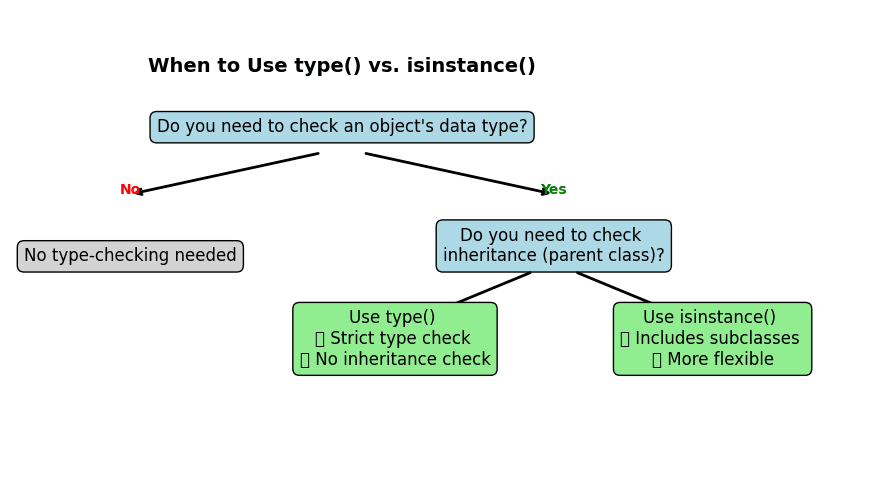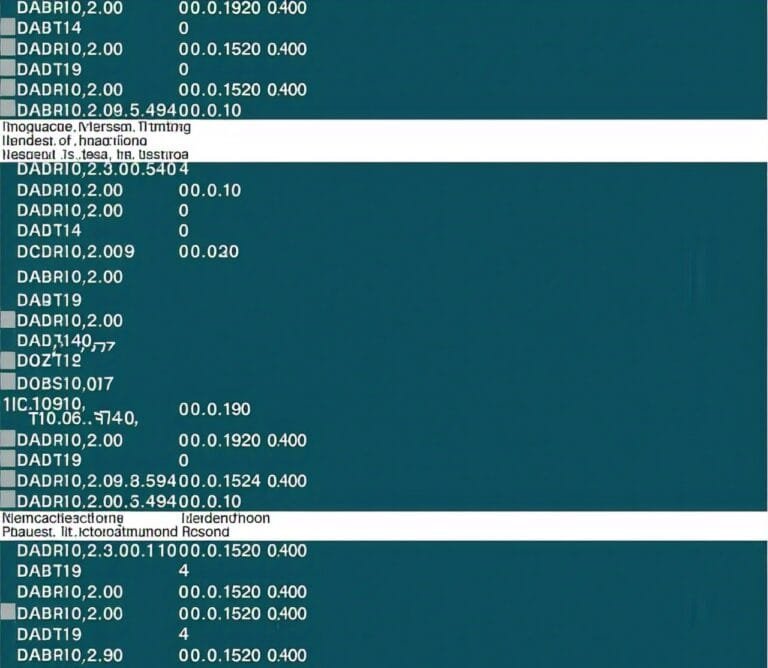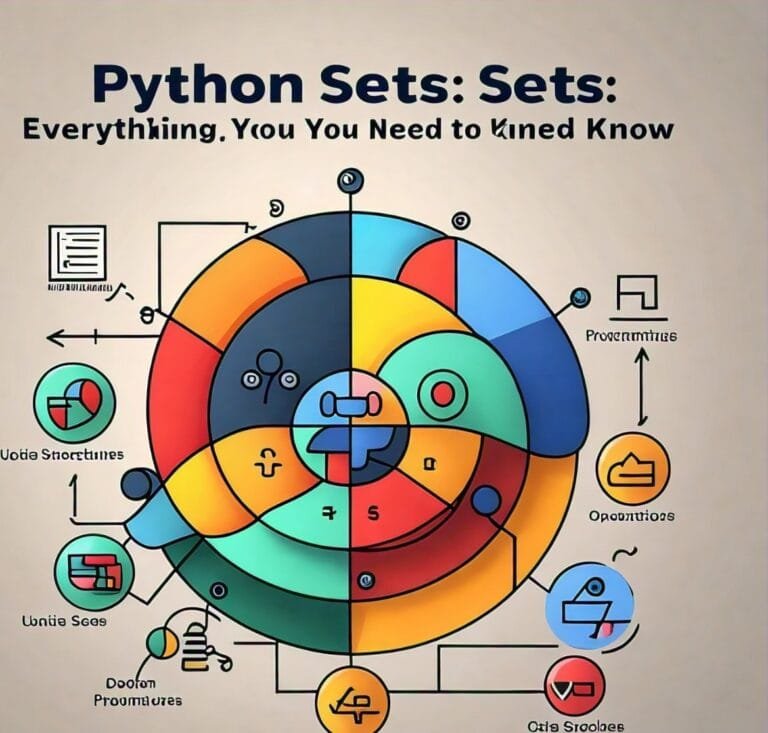Python type() Function: The Simple Trick to Checking Data Types
Introduction
Ever run into a TypeError in Python and thought, Wait… what just happened? Don’t worry, we’ve all been there! The type() function is like a quick detective—it tells you exactly what kind of data you’re working with so you can avoid those annoying surprises.
Why Should You Care About Data Types?
Python is dynamically typed, meaning you don’t have to declare variable types. Sounds great, right? Well… it also means Python won’t stop you from accidentally mixing things up.
Here’s where checking data types saves the day:
- Debugging: Got a weird error? Check if your variable is what you think it is.
- Type Conversions: Need to turn a string into a number? Make sure it’s actually a string first!
- Data Validation: If you’re building something that takes user input, you definitely want to check what kind of data you’re getting.
So, let’s jump in and see how type() can make your Python life easier!
Understanding the type() Function in Python
The type() function in Python is used to find out what type of data an object belongs to. This is helpful when you want to check whether a value is an integer, a string, a list, or any other type of object.

Basic Syntax
type(object)
How type() Works
When you pass an object inside type(), Python will return the class type of that object. This tells you what kind of data you’re dealing with.
Examples of type()
Checking the type of numbers
print(type(10)) # Output: <class 'int'>
print(type(3.14)) # Output: <class 'float'>
print(type(2 + 3j)) # Output: <class 'complex'>
10is an integer (int)3.14is a floating-point number (float)2 + 3jis a complex number (complex)
How to Use the Python type() Function (Explained Simply)
Checking Basic Data Types
Python has different types of data, such as numbers, text, and True/False values. You can use type() to check what type a value belongs to.
Example: Checking Numbers, Text, and Booleans
print(type(10)) # Output: <class 'int'> (This means 10 is an integer)
print(type(3.14)) # Output: <class 'float'> (This means 3.14 is a floating-point number)
print(type("Hello")) # Output: <class 'str'> (This means "Hello" is a string)
print(type(True)) # Output: <class 'bool'> (This means True is a boolean value)
Explanation:
10is a whole number, so it belongs to the integer (int) type.3.14has a decimal point, so it is a floating-point number (float)."Hello"is text, so it belongs to the string (str) type.True(orFalse) is used in conditions, and it belongs to the boolean (bool) type.
Checking Data Structures
Python allows you to store multiple values in lists, tuples, dictionaries, and sets. The type() function can help you determine which type of structure you are using.
Example: Checking Lists, Tuples, Dictionaries, and Sets
print(type([1, 2, 3])) # Output: <class 'list'> (This means [1, 2, 3] is a list)
print(type((1, 2, 3))) # Output: <class 'tuple'> (This means (1, 2, 3) is a tuple)
print(type({"name": "Alex"})) # Output: <class 'dict'> (This means {"name": "Alex"} is a dictionary)
print(type({1, 2, 3})) # Output: <class 'set'> (This means {1, 2, 3} is a set)
Explanation:
[1, 2, 3]is a list, which is a collection of values that can be changed.(1, 2, 3)is a tuple, which is like a list but cannot be changed.{"name": "Alex"}is a dictionary, which stores key-value pairs.{1, 2, 3}is a set, which stores unique values without duplicates.
Why is type() Useful?
- To check what kind of data you are working with before using it in a program.
- Avoid errors when performing operations (e.g., adding a number to a string will cause an error).
- To debug your code if something is not working as expected.
By using type(), you can make sure your program runs smoothly without unexpected errors.
Using the Python type() Function with Objects and Classes
The type() function doesn’t just work with basic data types like numbers and lists—it can also be used with custom classes. This helps you check what kind of object you are working with.
How type() Works with User-Defined Classes
In Python, you can create your own data types using classes. When you create an object from a class, you can use type() to check its type.
Example: Checking the Type of an Object
class Car:
pass # An empty class
my_car = Car()
print(type(my_car)) # Output: <class '__main__.Car'>
Explanation:
- We define a custom class called
Car. - We create an object
my_carfrom this class. - Using
type(my_car), Python tells us thatmy_caris an instance of our customCarclass.
The output <class '__main__.Car'> means that my_car is an object of the Car class, and it was created in the __main__ module (which is just the default module when running a script).
Why Use type() with Classes?
- To check if an object belongs to a user-defined class before performing specific operations on it.
- To debug your code by verifying the type of objects when working with object-oriented programming.
By using type(), you can better understand and control how objects behave in your program!
Difference Between type() and isinstance() in Python

Both type() and isinstance() help you check the type of an object, but they work differently.
type()checks the exact class of an object.isinstance()checks if an object belongs to a class or any of its parent classes (inheritance).
Example: type() vs. isinstance()
Let’s define a simple class structure:
class Animal:
pass
class Dog(Animal):
pass
my_dog = Dog()
Using type()
print(type(my_dog) == Dog) # True (my_dog is exactly a Dog)
print(type(my_dog) == Animal) # False (my_dog is not directly an Animal)
type(my_dog) == Dog→ True, becausemy_dogwas created fromDog.type(my_dog) == Animal→ False, becausetype()only checks the direct class, andDogis not exactlyAnimal(it’s a subclass).
Using isinstance()
print(isinstance(my_dog, Dog)) # True (my_dog is a Dog)
print(isinstance(my_dog, Animal)) # True (Dog is a subclass of Animal)
isinstance(my_dog, Dog)→ True, becausemy_dogis an instance ofDog.
isinstance(my_dog, Animal)→ True, becauseDoginherits fromAnimal, somy_dogis also considered anAnimal.
Key Differences
| Feature | type() | isinstance() |
|---|---|---|
| Checks | Exact class | Class + Parent classes (Inheritance) |
| Works with Inheritance? | ❌ No | ✅ Yes |
Example (my_dog) | type(my_dog) == Dog ✅type(my_dog) == Animal ❌ | isinstance(my_dog, Dog) ✅isinstance(my_dog, Animal) ✅ |
When to Use Which?
✔ Use type() when you need to check the exact class and don’t want to include subclasses.
✔ Use isinstance() when working with inheritance, especially when you need to check if an object belongs to a class or its parent class.
By understanding this difference, you can write better and more flexible Python code!
Must Read
- History of AI
- Interactive Introduction to AI: Machine Learning, Neural Networks & Supervised Learning for Beginners
- Python String Comparison Tutorial: Complete Guide
- How to Build a Python Port Scanner From Scratch
- Complete Beginner’s Guide to Hashing and Cryptography in Python
Using type() in Conditional Statements
You can use type() in if-else conditions to check the data type of a variable before performing an operation.
Example: Checking Data Type with type()
value = 100
if type(value) == int:
print("Value is an integer")
elif type(value) == str:
print("Value is a string")
else:
print("Unknown type")
How It Works:
- If
valueis an integer, it prints"Value is an integer". - V
alueis a string, it prints"Value is a string". - If
valueis neither, it prints"Unknown type".
⚠ Warning: isinstance() is Often a Better Choice
Using type() like this is not always the best approach because it only checks the exact class and ignores inheritance. In most cases, isinstance() is more flexible.
Better Approach: Using isinstance()
if isinstance(value, int):
print("Value is an integer")
elif isinstance(value, str):
print("Value is a string")
else:
print("Unknown type")
Why is isinstance() Better?
✔ Works with subclasses: If a variable is an instance of a subclass (e.g., a custom number class), isinstance() will still recognize it as an int, while type() won’t.
✔ More flexible: You can check multiple types at once, e.g., isinstance(value, (int, float)) to allow both integers and floats.
💡 Best practice: Use isinstance() in conditional checks unless you specifically need to check for an exact type.
Checking Function Return Types with type()
The type() function is very useful when working with functions, especially for debugging and making sure a function returns the expected data type.

Example: Using type() to Verify Function Output
def get_data():
return [1, 2, 3] # Function returns a list
print(type(get_data())) # Output: <class 'list'>
How It Works:
- The function
get_data()returns a list[1, 2, 3]. type(get_data())checks the type of the returned value.- The output
<class 'list'>confirms that the function returns a list.
Why Is This Useful?
- Debugging: If a function unexpectedly returns a different type,
type()can help identify the issue. - Ensuring Consistency: When working with APIs or large programs, you can confirm that functions return consistent data types.
- Preventing Errors: If your function is supposed to return a list but returns a string instead,
type()can catch it before errors occur.
Example: Debugging Unexpected Return Types
def process_number(num):
if num > 10:
return "Large number" # Returns a string
else:
return num * 2 # Returns an integer
result = process_number(15)
print(type(result)) # Output: <class 'str'>
Why This is a Problem?
- The function sometimes returns an integer and sometimes a string.
- This inconsistency can cause errors if another part of the program expects only numbers.
💡 Best practice: If a function should always return the same type, use type() to verify it during development and debugging!
Common Mistakes When Using Python type() Function
While type() is useful, it’s easy to misuse it in ways that lead to errors or unexpected behavior. Here are some common mistakes and how to avoid them.
Mistake 1: Using type() Instead of isinstance() for Class Hierarchy Checks
❌ Incorrect Usage
class Animal:
pass
class Dog(Animal):
pass
my_dog = Dog()
print(type(my_dog) == Animal) # False (Unexpected)
type(my_dog) == Animalreturns False becausemy_dogis an instance ofDog, notAnimal.type()only checks the exact class, not parent classes.
✅ Correct Approach: Use isinstance()
print(isinstance(my_dog, Animal)) # True
- This correctly returns True because
Dogis a subclass ofAnimal, andisinstance()considers inheritance.
Mistake 2: Comparing type() Outputs as Strings Instead of Class Types
❌ Incorrect Usage
print(type(10) == "int") # False (Incorrect way to compare types)
"int"is just a string, not the actualintclass.type(10)returns<class 'int'>, so comparing it to"int"doesn’t work.
✅ Correct Approach: Compare with Class Types
print(type(10) == int) # True (Correct way)
- Always compare
type()output with the class name (likeint,str,list, etc.), not as a string.
Mistake 3: Forgetting That Some Python Types Are Mutable
Python has mutable (changeable) and immutable (unchangeable) data types.
Using type() without considering mutability can cause unexpected behavior.
Example: Mutable Lists
my_list = [1, 2, 3]
print(type(my_list)) # Output: <class 'list'>
my_list.append(4) # Modifies the original list
print(my_list) # Output: [1, 2, 3, 4]
- Lists are mutable, meaning they can be changed after creation.
- If you expect an unchangeable type, consider using tuples instead.
Example: Immutable Tuples
my_tuple = (1, 2, 3)
print(type(my_tuple)) # Output: <class 'tuple'>
my_tuple[0] = 10 # ❌ Error! Tuples are immutable
- Tuples cannot be modified after creation.
- If you need fixed data, a tuple might be a better choice than a list.
How to Avoid These Mistakes?
- Use
isinstance()instead oftype()when checking inheritance. - Always compare
type()output with actual class names (e.g.,int,str,list), not strings. - Understand mutable vs. immutable types before applying
type()checks.
By keeping these points in mind, you can use type() effectively and avoid common pitfalls in Python!
Practical Applications of type() in Real-World Coding
The type() function isn’t just for checking types in small scripts—it has real-world applications in debugging, validation, and testing. Here’s how it can be useful in practical scenarios:
1. Debugging: Identifying Unexpected Data Types
Sometimes, errors happen because a variable has an unexpected type. type() helps diagnose the issue.
Example: Debugging a Function
def divide_numbers(a, b):
print(f"Type of a: {type(a)}, Type of b: {type(b)}")
return a / b
result = divide_numbers(10, "5") # This will cause an error
Why is this helpful?
- If
bis a string instead of a number, Python will raise an error. - The
print(type(a))statement helps identify the issue before the error occurs.
2. Data Validation: Ensuring Correct Input Types
You can use type() to validate function inputs and prevent unexpected behavior.
Example: Validating User Inputs
def add_numbers(a, b):
if type(a) != int or type(b) != int:
raise TypeError("Inputs must be integers")
return a + b
print(add_numbers(10, 5)) # ✅ Works fine
print(add_numbers(10, "5")) # ❌ Raises TypeError
Why is this useful?
- Prevents wrong inputs from causing issues later in the program.
- Provides clear error messages instead of letting Python raise unexpected errors.
3. Handling API Responses: Verifying JSON Data Types
When working with APIs, you often receive JSON data. type() helps confirm that the data is in the expected format before processing it.
Example: Checking API Response Data
import json
response = '{"name": "Alice", "age": 25, "is_member": true}' # JSON string
data = json.loads(response) # Convert JSON string to dictionary
if type(data) == dict:
print("Valid API response:", data)
else:
print("Invalid response format")
Why is this important?
- Ensures that the API returns a dictionary and not a string or list.
- Prevents errors when trying to access data keys in unexpected formats.
4. Testing and Assertions: Confirming Function Return Types
When writing unit tests, you can use type() to ensure functions return the correct data type.
Example: Using Assertions for Testing
def get_items():
return ["apple", "banana", "cherry"] # Function returns a list
assert type(get_items()) == list, "Function should return a list"
print("Test passed ✅")
Why is this helpful?
- Automates testing by checking the expected output type.
- Prevents functions from returning the wrong data type by mistake.
Key Takeaways
- Debugging: Identify unexpected data types in errors.
- Data Validation: Ensure function inputs are in the correct format.
- Handling API Responses: Verify JSON data before processing.
- Testing & Assertions: Check that functions return expected types.
Using type() wisely can save time, prevent errors, and make your code more reliable!
Conclusion
The type() function in Python is a powerful tool for identifying object types, debugging errors, validating inputs, and ensuring correct function outputs. While it provides quick type checks, it’s essential to use it correctly—especially when working with class hierarchies, where isinstance() is often the better choice.
By integrating type() into real-world scenarios like debugging, API data handling, and unit testing, you can write more reliable and error-free code. However, always remember that understanding the data type is just the first step—your code should also handle unexpected types gracefully to avoid crashes and improve user experience.
Want to explore more Python tips and best practices? Stay tuned for more insights on Emitech Logic!
Bonus: Quick Reference Table
Here’s a structured table showing how the type() function works with different data types in Python.
Table: type() Function Output for Various Data Types
| Python Object | type(object) Output |
|---|---|
"Hello" | <class 'str'> |
42 | <class 'int'> |
3.14 | <class 'float'> |
[1, 2, 3] | <class 'list'> |
{"name": "AI"} | <class 'dict'> |
(10, 20, 30) | <class 'tuple'> |
{1, 2, 3} | <class 'set'> |
True | <class 'bool'> |
None | <class 'NoneType'> |
b"bytes" | <class 'bytes'> |
bytearray(5) | <class 'bytearray'> |
complex(2, 3) | <class 'complex'> |
lambda x: x + 1 | <class 'function'> |
class MyClass: pass | <class 'type'> (for classes) |
This quick reference table makes it easy to check what type() returns for different objects.
FAQs on Python type() Function
1. When should I use type() vs. isinstance()?
type() when you need to check the exact class of an object. However, if you are dealing with class inheritance, isinstance() is a better choice because it checks if an object belongs to a class or any of its parent classes.2. Can I compare type() outputs as strings?
type() outputs with class names, not strings.✅ Correct:
type(10) == int❌ Incorrect:
type(10) == "int"3. Is type() useful for debugging?
type() is often used to print and check variable types when debugging. This helps identify incorrect data types before they cause runtime errors.4. How does type() work with user-defined classes?
type() returns the class name.class Car: pass my_car = Car() print(type(my_car)) # Output: <class '__main__.Car'>This confirms that
my_car is an instance of the Car class.External Resources
Official Python Documentation – Built-in Functions: type()
- The official Python documentation provides a detailed explanation of
type(), its usage, and examples.








Leave a Reply